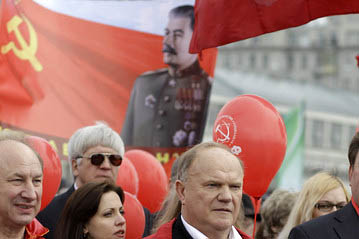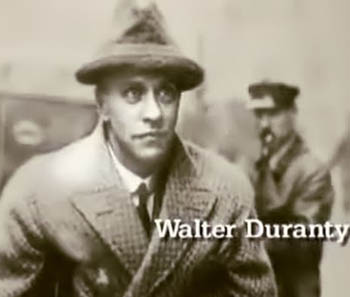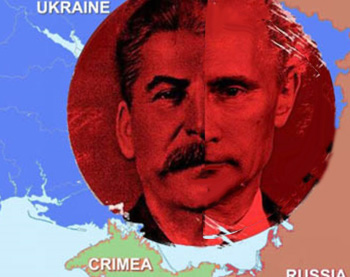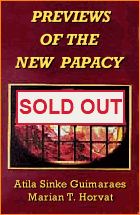International Affairs
 |
 |
 |
 |
 |
 |
 |
Whitewashing Works:
Progress through Murder
Fear and disorder breed calls for a “strongman.” The cry is again heard in Europe and even in the United States for a man of strength who will solve our problems, regardless of law or tradition. Similar cries were heard in the 1920s and 1930s with horrific results. Today, admiration for the “strongman” is particularly remarkable in Russia and that admiration extends to one of the worst monsters in human history.
 The Communist Party of the Russian Federation is planning to freely use images of former Soviet leader and mass murderer Josef Stalin in upcoming elections. The leader of Russia’s Communist Party, Gennady Zyuganov, also stated in an interview with the Russian news service RIA Novosti, that the communists will not only make use of Stalin’s image but also of the “achievements of the Soviet Union in the Leninist-Stalinist era.”
The Communist Party of the Russian Federation is planning to freely use images of former Soviet leader and mass murderer Josef Stalin in upcoming elections. The leader of Russia’s Communist Party, Gennady Zyuganov, also stated in an interview with the Russian news service RIA Novosti, that the communists will not only make use of Stalin’s image but also of the “achievements of the Soviet Union in the Leninist-Stalinist era.”
Human rights advocates are outraged.
The elections will be held in September and involve seats in the Duma, the lower house of the Russia’s legislature. The upper house is the Federal Assembly, but the Duma is the more powerful of the two chambers. The communists are expecting a big victory and are counting on controlling the Duma, which has been dominated by Russian President Vladimir Putin’s United Russia since 2003.
An increasing number of Russians regard the Stalinist era as positive and excuse Stalinist crimes as necessary. The RIA Novosti article that quoted Zyuganov also cited recent polls by Moscow’s Levada Center indicating that Stalin’s “positives” (admiration, respect) now surpass his “negatives” (fear, disgust), 37% to 17% with the remainder undecided (too fearful to respond?). In 2001 the numbers were reversed, 43% “dislike” to 38% “admiration,” with far fewer unwilling or otherwise unable to give a response. While 45% of Russians still believe that political repression is a crime without justification, 71% held that belief in 2007.
Just over a quarter, 26% of respondents to another recent poll, also cited in the article, believe that the infamous purge trials (also known as “show trials”) of the 1930s were justified. Stalin had used the purge trials to rid himself of real or imagined enemies. The purge trials crippled the Soviet army to the point that the Soviet Union could not adequately respond to the Nazi attack in June 1941.
The approval numbers for Stalin’s purge trials have steadily increased since 2007.
The trend is not good. The growing admiration for Stalin as well as the Soviet Union is no accident. The Russian government under Putin has been noticeably active in placing the defunct Union of Soviet Socialist Republics in the best possible light, as well as the most infamous of its leader, Josef Stalin.
 The rise in the acceptance of the mass murderer Stalin now gives the communists a recognizable figure admired for his “strength” and for making the Soviet Union into a world power.
The rise in the acceptance of the mass murderer Stalin now gives the communists a recognizable figure admired for his “strength” and for making the Soviet Union into a world power.
The West would do well to watch carefully events in a nation willing to excuse crimes for “strength” in leadership. Aggression all too often is equated with “strength.” The most succinct justification for the “excesses” of the “strongman” was made in the early 1930s by The New York Times correspondent in Moscow, Walter Duranty. At the time, Stalin was determined to subdue all who resisted forced collectivization of agriculture. The Ukrainian farmers, the so-called “kulaks,” were particularly difficult to manage.
The conflict between the Ukrainians and Stalin demonstrated two of the most important attributes of the “strongman.” First, the willingness to crush all opposition through legal or non-legal means; second, the ability to obtain support from a willing media.
Stalin ordered quotas of grain from Ukraine far above any capacity to comply. Grain supplies were confiscated, but farm families were not allowed even to glean grain from the harvested fields. The Soviet political police (by that time known by the initials NKVD) prowled farms and villages shooting without warning anyone attempting to gather bits of grain. The once productive Ukrainian countryside became a place of starvation and terror. Entire villages ceased to exist. The communist authorities raised flags indicating plague was present in the desolate villages, attempting to hide that the real plague was politically-induced mass starvation. Some groups attempted to take refuge in forested areas, but Soviet authorities burned down the forests.
Today, the Ukrainian people recall this vicious act as the “Holodomor” or “Hunger-Extermination.”
Stalin’s actions were hidden by a supportive press. The lead man in the cover-up was The New York Times Moscow correspondent, Walter Duranty. He was regarded as the “dean” of all the Moscow correspondents, the go-to-man for inside information on the Soviet Union.
 He also cooperated fully with Soviet authorities.
He also cooperated fully with Soviet authorities.
Duranty followed the official Soviet line and denied the existence of the man-made famine, but at one point callously conceded that “you can’t make an omelet without breaking a few eggs.”
The safe path for a reporter was to go along with Duranty. Those who did not, found their careers ruined.
Not until Robert Conquest published Harvest of Sorrow in 1986, did the true horror of Stalin’s actions become generally known.
The true “strongman” is, in reality, the ruthless man, the one who is willing to go to any length to have complete power. Nothing less will do. The rights of others are meaningless to the “strongman” who knows best for all – because he says so.
Without these elements there is no real “strongman,” just an ineffective imitation. Fear and favors, death and terror are what he provides, playing to an adoring public with all faults hidden or mitigated by a subservient media.
Any group of people that gives itself over to the “strongman” also gives away any sense of individual humanity for itself or others, including the people of other nations.
The cult of the “strongman” leads only to personal and national disaster.

Toby Westerman publishes
International News Analysis - Today
An uncompromising weekly analysis of the world situation
Contact T. Westerman at
www.inatoday.com
or P.O. BOX 5182, Rockford, ILL, 61125-0182

The head of the Communist Party Zyuganov, center, raises Stalin posters to campaign for Putin
Human rights advocates are outraged.
The elections will be held in September and involve seats in the Duma, the lower house of the Russia’s legislature. The upper house is the Federal Assembly, but the Duma is the more powerful of the two chambers. The communists are expecting a big victory and are counting on controlling the Duma, which has been dominated by Russian President Vladimir Putin’s United Russia since 2003.
An increasing number of Russians regard the Stalinist era as positive and excuse Stalinist crimes as necessary. The RIA Novosti article that quoted Zyuganov also cited recent polls by Moscow’s Levada Center indicating that Stalin’s “positives” (admiration, respect) now surpass his “negatives” (fear, disgust), 37% to 17% with the remainder undecided (too fearful to respond?). In 2001 the numbers were reversed, 43% “dislike” to 38% “admiration,” with far fewer unwilling or otherwise unable to give a response. While 45% of Russians still believe that political repression is a crime without justification, 71% held that belief in 2007.
Just over a quarter, 26% of respondents to another recent poll, also cited in the article, believe that the infamous purge trials (also known as “show trials”) of the 1930s were justified. Stalin had used the purge trials to rid himself of real or imagined enemies. The purge trials crippled the Soviet army to the point that the Soviet Union could not adequately respond to the Nazi attack in June 1941.
The approval numbers for Stalin’s purge trials have steadily increased since 2007.
The trend is not good. The growing admiration for Stalin as well as the Soviet Union is no accident. The Russian government under Putin has been noticeably active in placing the defunct Union of Soviet Socialist Republics in the best possible light, as well as the most infamous of its leader, Josef Stalin.

His lies about Stalin helped the dictator kill millions
The West would do well to watch carefully events in a nation willing to excuse crimes for “strength” in leadership. Aggression all too often is equated with “strength.” The most succinct justification for the “excesses” of the “strongman” was made in the early 1930s by The New York Times correspondent in Moscow, Walter Duranty. At the time, Stalin was determined to subdue all who resisted forced collectivization of agriculture. The Ukrainian farmers, the so-called “kulaks,” were particularly difficult to manage.
The conflict between the Ukrainians and Stalin demonstrated two of the most important attributes of the “strongman.” First, the willingness to crush all opposition through legal or non-legal means; second, the ability to obtain support from a willing media.
Stalin ordered quotas of grain from Ukraine far above any capacity to comply. Grain supplies were confiscated, but farm families were not allowed even to glean grain from the harvested fields. The Soviet political police (by that time known by the initials NKVD) prowled farms and villages shooting without warning anyone attempting to gather bits of grain. The once productive Ukrainian countryside became a place of starvation and terror. Entire villages ceased to exist. The communist authorities raised flags indicating plague was present in the desolate villages, attempting to hide that the real plague was politically-induced mass starvation. Some groups attempted to take refuge in forested areas, but Soviet authorities burned down the forests.
Today, the Ukrainian people recall this vicious act as the “Holodomor” or “Hunger-Extermination.”
Stalin’s actions were hidden by a supportive press. The lead man in the cover-up was The New York Times Moscow correspondent, Walter Duranty. He was regarded as the “dean” of all the Moscow correspondents, the go-to-man for inside information on the Soviet Union.

A new strongman ... the same goal and tactics
Duranty followed the official Soviet line and denied the existence of the man-made famine, but at one point callously conceded that “you can’t make an omelet without breaking a few eggs.”
The safe path for a reporter was to go along with Duranty. Those who did not, found their careers ruined.
Not until Robert Conquest published Harvest of Sorrow in 1986, did the true horror of Stalin’s actions become generally known.
The true “strongman” is, in reality, the ruthless man, the one who is willing to go to any length to have complete power. Nothing less will do. The rights of others are meaningless to the “strongman” who knows best for all – because he says so.
Without these elements there is no real “strongman,” just an ineffective imitation. Fear and favors, death and terror are what he provides, playing to an adoring public with all faults hidden or mitigated by a subservient media.
Any group of people that gives itself over to the “strongman” also gives away any sense of individual humanity for itself or others, including the people of other nations.
The cult of the “strongman” leads only to personal and national disaster.

Posted June 3, 2016
International News Analysis - Today
An uncompromising weekly analysis of the world situation
Contact T. Westerman at
www.inatoday.com
or P.O. BOX 5182, Rockford, ILL, 61125-0182
______________________
______________________
 Volume I |
 Volume II |
 Volume III |
 Volume IV |
 Volume V |
 Volume VI |
 Volume VII |
 Volume VIII |
 Volume IX |
 Volume XI |
 Special Edition |
 Special Edition |


